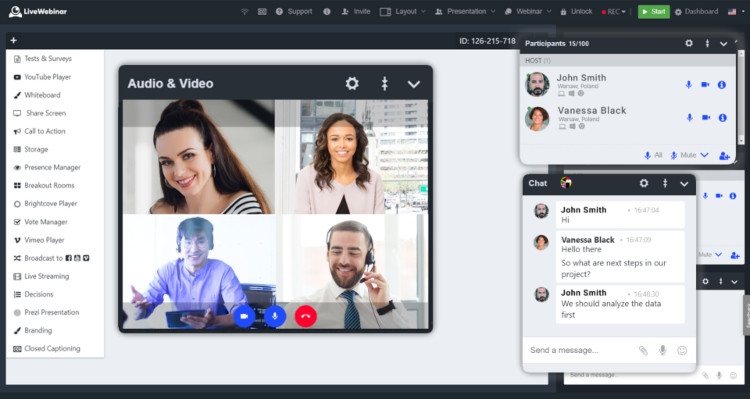Giving up on ‘old’ content that’s been pushed down in your feeds is often not very appealing. However, making good use of it is difficult. In order to help you come up with a solution that fits your needs, we’ve put together a guide to the top 10 content repurposing methods to help you increase traffic!
Blog post to an infographic
One of the top content repurposing methods to help you increase traffic is transforming blog posts into visually appealing infographics.
Infographics are powerful tools that combine text and visuals to present information concisely and engagingly. They are highly shareable on social media platforms and have the potential to go viral, driving more traffic to your website! So, by repurposing your blog posts into infographics, you can reach a wider audience and captivate them with eye-catching visuals and easy-to-digest information.
The first step in converting a blog post into an infographic is to identify the key points and main ideas from your original content. Then, condense the information into bite-sized chunks that can be easily understood and remembered. Make sure to keep the language simple and concise, avoiding jargon or technical terms that might confuse your audience! Next, select or create relevant visuals such as icons, charts, or graphs that support and enhance the information you are presenting. The visuals should be appealing and aligned with your brand’s aesthetics.
When designing the layout of your infographic, make sure it is easy to follow. So, use a clear and logical flow to guide the reader through the information. Start with an attention-grabbing title and introduction that hooks the reader’s interest. Then, organize the content into sections or steps, using headings or subheadings to divide the information. Finally, use a combination of text and visuals to present the key points, ensuring a balance between the two.
To ensure your infographic is SEO-friendly, include relevant keywords in the title, headings, and captions. Provide alt text for the visuals, too, describing them in a concise and keyword-rich manner. Include social sharing buttons on your infographic to encourage readers to share it on their social media platforms!
E-book from blog series
Repurposing your blog series into an e-book is a highly effective method that can significantly boost your content’s appeal.
After all, compiling your blog posts into a comprehensive e-book provides your audience with a convenient and easily accessible resource they can reference and consume at their own pace.
When repurposing your blog series into an e-book, it’s essential to choose a cohesive theme or topic that connects all the blog posts. This helps create a logical flow and ensures that the e-book feels like a unified piece of content. So, review your blog posts and identify the core ideas and key points you want to include in the e-book. Then, condense and reorganize the content, making sure to maintain its readability and coherence. You can do this if you break down complex concepts into easily understandable sections and use clear headings and subheadings to guide the reader.
To enhance the visual appeal of your e-book, incorporate high-quality images that align with your content. Use images that support the text and provide visual examples or representations of the concepts discussed! Furthermore, include charts, graphs, or diagrams to present data or statistics in a visually appealing and easily understandable format. Additionally, ensure the images are high-resolution and properly formatted for optimal viewing.
Once your e-book is ready, you can promote it on your website and across your social media channels. Or you can offer it as a free resource in exchange for readers’ email addresses, allowing you to build your email list and nurture leads! You can even engage with your audience by asking for feedback or encouraging them to share the e-book with others.
Video tutorials from how-to guides
Repurposing your how-to guides into video tutorials is a powerful method that can significantly boost your content’s reach and appeal. This is because video tutorials provide a dynamic and interactive way for your audience to learn and follow along with your instructions. And by transforming your step-by-step guides into engaging videos, you can captivate your viewers and provide them with a more immersive learning experience!
To create video tutorials from your how-to guides, start by identifying the key steps and instructions from your original content. Then, break down the process into manageable segments that can be easily followed and understood. Keep your explanations concise and clear, using actual demonstrations to enhance comprehension. Finally, prioritize the visual elements of your video tutorials, as they play a crucial role in engaging your audience and effectively conveying information.
When filming your video tutorials, ensure that the lighting, sound quality, and video resolution are of high standard. So, invest in a decent camera or smartphone with good video capabilities, and consider using external microphones for improved audio clarity. Plan and script your tutorials in advance, maintaining a friendly and conversational tone throughout. Moreover, speak clearly and at a comfortable pace, allowing viewers to follow along easily.
Once done, optimize your video tutorials for search engines by providing keyword-rich titles, descriptions, and tags. Choose descriptive and engaging titles that accurately reflect the content of the tutorial! Then, write comprehensive descriptions highlighting the key points and include relevant keywords to improve discoverability. Don’t forget to include links to your website or related resources in the video description to drive traffic back to your site, either!

Webinar from expert interviews
Another one of the useful content repurposing methods to help you increase traffic is transforming expert interviews into webinars.
Webinars provide a platform for you to share valuable insights and knowledge directly from industry experts. So, by leveraging the expertise of these professionals, you can create compelling and interactive webinar sessions that offer immense value to your audience.
To repurpose expert interviews into webinars, start by selecting interviews that cover pertinent and valuable topics. Then, try to identify the key insights and takeaways from these interviews that would be of interest to your audience. Finally, condense the information into a structured and coherent format that can be presented effectively in a webinar setting. Of course, you should also organize the content into logical sections or topics and plan the webinar flow to keep the audience engaged.
When conducting the webinar, ensure that you have a reliable and user-friendly webinar platform—practice using the platform in advance to familiarize yourself with its features and functionality, too. Furthermore, prepare a presentation that complements your content and provides an engaging experience for the attendees. And incorporate relevant visuals, such as slides, charts, and graphs, to support and enhance shared information.
You should also engage your audience during the webinar by encouraging participation and interaction. So, incorporate live polls, Q&A sessions, and interactive elements to keep the audience involved and interested! Consider incorporating case studies, real-life examples, and practical tips to provide actionable insights that attendees can implement in their own endeavors, too.

Slide decks from research reports
Repurposing research reports into slide decks is a great potential strategy. Slide decks offer a concise and visually stimulating format that presents complex information in a more digestible manner. So, by condensing your research report into key findings and visually appealing slides, you can capture the attention of your audience and convey the essence of your research in a more engaging way.
To repurpose your research report into a slide deck, start by identifying the most important and impactful findings from your report. Focus on the key data, statistics, and insights that highlight the main conclusions and implications of your research! Then, condense the information into points that can be presented on individual slides.
When designing your slide deck, prioritize visual elements that enhance comprehension and engagement. So, use graphs, charts, and visuals to present data and statistics in an easily understandable format. Choose a cohesive and visually appealing design theme that aligns with your brand’s aesthetics and ensures consistency throughout the slide deck, too.
Another important point is to ensure that each slide tells a story and follows a logical flow. So, use clear and concise headings and subheadings to guide the reader throughout. You should also keep the text on each slide minimal, using bullet points or short sentences to convey key messages. This is done to avoid overwhelming your audience with too much information on a single slide.
Finally, for promotion, you can embed the slide deck within relevant blog posts or share it as a standalone resource.
Podcast episodes from blog content
Repurposing your blog content into podcast episodes is a highly effective strategy that lets you use the results in various ways. This is because podcasts offer a convenient and portable format for consuming content, making it easier for your audience to engage with your brand on the go.
To repurpose your blog content into podcast episodes, select blog posts that are well-suited for the audio format. So, go for topics that lend themselves to discussion or storytelling, as podcasts thrive on conversational and narrative elements. Then, adapt the structure of your blog posts to fit the podcast format by expanding on ideas, adding anecdotes, or including interviews with experts.
When recording your podcast episodes, ensure that you have a good-quality microphone and a quiet recording environment. Speak naturally and conversationally, as if you were having a discussion with your audience! You can also incorporate storytelling techniques to captivate your listeners and keep them engaged throughout the episode.
Incidentally, you can also perfectly pair this content repurposing with affiliate marketing for even better results. During your podcast episodes, mention relevant products or services that align with your content and offer value to your audience. Or incorporate unique affiliate links or discount codes that listeners can use to make purchases and earn commissions for each successful referral. Alternatively, you can leave the podcast entirely in the hands of an affiliate marketer you trust by letting them record the whole thing! This comes with the added benefit of using their own channels and platforms to promote the podcast and your website.

Social media snippets from video content
Repurposing your video content into social media snippets is a powerful approach that can significantly enhance your online presence and boost your profits. After all, social media platforms thrive on bite-sized and visually impressive content, making snippets from your video content a perfect fit. So, just by extracting captivating snippets from your videos and sharing them across social media, you can grab the attention of your audience and entice them to engage with your brand.
To repurpose your video content into social media snippets, carefully review your videos and identify the most impactful and attention-grabbing moments. Then, look for visually appealing scenes, powerful quotes, or intriguing demonstrations that encapsulate the essence of your video. Trim these segments into short snippets that are easily consumable on social media platforms, and you are set.
Of course, when creating social media snippets, ensure they are properly edited. For example, add subtitles or captions to the snippets to make them accessible to viewers who prefer watching videos without sound. And you can also incorporate branding elements such as logos or watermarks to reinforce your brand’s identity and increase brand recognition.
You should share your social media snippets across various platforms such as Instagram, Facebook, Twitter, and LinkedIn. To do this, tailor the format and dimensions of the snippets to fit the requirements of each platform. You can also experiment with different posting times and schedules to find the optimal timing for maximum engagement.
Finally, you can track the performance of your social media snippets using analytics tools provided by the platforms. Monitor metrics such as views, likes, comments, and shares to gain insights into the effectiveness of your snippets. And then, use the data to refine your strategy and create more targeted and compelling snippets in the future!
Quizzes from how-to articles
If you are looking for unusual content repurposing methods to help you increase traffic, you need to consider transforming your how-to articles into interactive quizzes! Quizzes are an effective method to captivate your readers and provide them with an enjoyable and educational experience. And by repurposing your how-to articles into quizzes, you can transform passive readers into active participants! Thus, making the learning process more interactive and entertaining, even if the original content would have made for dry reading.
To create quizzes from your how-to articles, identify key questions and decision points from the original content. Then, separate the information into meaningful and digestible chunks that can be turned into quiz questions. Just remember to ensure that the questions are clear and concise, avoiding ambiguity or confusion! For example, you can provide multiple-choice options that challenge your readers and encourage critical thinking.
When designing your quizzes, consider incorporating visuals and multimedia elements to enhance the overall experience. So, use interesting images, videos, or audio clips that complement the questions and provide additional context. This is useful because visual cues can improve engagement and help your audience retain information more effectively.
Email courses from pillar content
Repurposing your pillar content into email courses is an effective strategy that allows you to deliver in-depth knowledge and build a stronger connection with your subscribers.
Pillar content is the foundation of your expertise, covering broad topics in detail. And by repurposing this content into a series of email lessons, you can break down complex concepts into digestible chunks. And even deliver them directly to your audience’s inbox!
To start the process of making email courses from pillar content, select the most relevant and comprehensive sections of it. Then, identify key subtopics or sections that can be transformed into individual email lessons. You then separate the resulting content into a logical sequence. Thereby ensuring that each email builds upon the previous one and provides a coherent learning experience!
When crafting your email lessons, focus on delivering valuable and actionable information to your subscribers. So, keep the lessons concise and easy to understand, utilizing a conversational tone that resonates with your audience. Remember that they need to actually understand and use the knowledge, not become consummate professionals immediately! Finally, include examples, case studies, or practical exercises to encourage engagement and application of the concepts discussed.
Case studies from customer testimonials
One of the content repurposing methods to help you increase traffic we have for you is turning customer testimonials into case studies. After all, customer testimonials offer valuable insights into the experiences and satisfaction of your customers that make this possible. By transforming these testimonials into comprehensive case studies, you can provide a deeper analysis of the challenges, solutions, and outcomes.
To create case studies from customer testimonials, start by selecting testimonials that highlight unique and compelling stories. You should also look for testimonials that showcase the transformation, success, or problem-solving abilities associated with your products or services! Finally, choose testimonials that cover a range of industries or use cases to demonstrate versatility. This lets you maximize the usefulness of your case studies to your entire audience!
When crafting your case studies, expand on the testimonials by providing more context, background information, and details. For example, describe the specific challenges or goals faced by the customers and explain how your product or service addressed those issues. Include specific metrics, statistics, or tangible results to quantify the impact and effectiveness of your offerings, too.
Content repurposing methods to help you increase traffic and maximize your ROI
With our top 10 content repurposing methods to help you increase traffic, you’ll breathe new life into old content and maximize the returns on your investment!
About the Author

Alex Reynolds is a seasoned writer and content strategist with CRM software and technology expertise. With years of experience working for MoversTech CRM, Alex has developed a deep understanding of how content can revolutionize business operations and customer interactions. Combining a passion for technology with a knack for simplifying complex concepts, Alex is dedicated to sharing insights, tips, and strategies to help businesses optimize content strategies and achieve sustainable growth!


